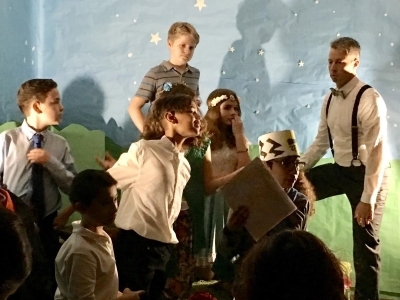A Response to ChatGPT: Suggestions for Addressing AI in the Humanities
Topics

Educators often take advantage of educational technologies as they make the shifts in instruction, teacher roles, and learning experiences that next gen learning requires. Technology should not lead the design of learning, but when educators use it to personalize and enrich learning, it has the potential to accelerate mastery of critical content and skills by all students.
With these five recommendations, educators can equip students with the skills needed to thrive in a rapidly changing world where we can expect nearly every knowledge job will be aided by AI.
Which of the following paragraphs were written by 8th-grade students and which were written by OpenAI’s ChatGPT?
1: It was my first official day being the president. I woke up early that day because I was extremely eager to begin my work…I eventually found myself making my way to the walk-in closet across the room. In it were countless pants, shirts, shoes, and ties that were all unique….I heard a knock on the door and called for them to come in. It was my maid. Yes, I had a maid! I couldn’t believe it….My office was humongous and was covered floor to ceiling with rows and rows of books. In front of gigantic windows, was my desk, where I sat for many hours of the day stressing out over papers I needed to sign and decisions I had to make. It wasn’t as simple as I thought…
2: One morning, I woke up to discover that I had become the President of the United States. I was shocked and amazed, but I quickly realized that I had a huge responsibility on my shoulders. I got dressed and headed to the White House, where I was greeted by the Secret Service and my staff. They told me that I had a busy day ahead of me, with meetings with foreign leaders and important decisions to make. I met with the Vice President and the rest of the Cabinet, and we discussed the major issues facing the country. I listened carefully to their advice, and made some tough decisions….
3: It was a typical Tuesday morning. I woke up, got dresesed, and went downstairs to eat breakfast. But as I was pouring myself a bowl of cereal, I heard a knock on the door. I opened it to find a man in a suit standing on my porch.
“Good morning, Madam President,” he said. “I’m here to take you to the White House.” I was stunned. I had no idea what he was talking about. I had never even run for presidnet…The man ushered me into a black car and we drove to the White House. When we arrived, I was greeted by a crowd of people and a flurry of flashing cameras. I was whisked inside and taken to the Oval Office, where I was given a briefing on the state of the nation.
If you weren't sure, you’re in good company.
The New York Times found that a fourth-grade teacher, a professional writing tutor, a Stanford education professor, and an award-winning children’s author all struggled to consistently identify writing that was produced by a human versus artificial intelligence (AI).
To the consternation of teachers around the world, AI is making it increasingly easier to plagiarize and harder to detect. While tools like OpenAI's own Text Classifier, AI Writing Check, and GPTZero can help teachers identify work produced by AI, they can also help students modify their work just enough to avoid being caught. As educators, our initial response to ChatGPT is understandably focused on how to stop students from cheating. However, in a world in the not-too-distant future where AI aids nearly every knowledge job, we educators will need to create learning tasks that can’t easily be done by AI and equip students with the skills needed to thrive in a rapidly changing world. Here are a few preliminary suggestions:
1. Focus on the Process
Natalie Wexler, who writes about education and cognitive science, provides a compelling answer to students who wonder why they need to learn to write if AI can now do it for them:
If writing were just a skill that is now being rendered obsolete…this development might not be so alarming. But writing is far more than that. When done well, it isn’t just a matter of displaying what you already know…The process of writing itself can and should deepen that knowledge and possibly spark new insights. So when students use ChatGPT, they’re not just cheating whatever institution is giving them credit for work they haven’t done. They’re also cheating themselves.
Beyond that, it’s been found that when students write about what they’re studying—in any subject—it boosts their retention of the material. That increases the store of knowledge in their long-term memories, which in turn makes it easier to acquire more knowledge. Knowledge, it’s been said, is like Velcro: it sticks best to other related knowledge.
Explicit writing instruction…helps students understand the texts they’re supposed to read. The syntax of written language is more complex than that of spoken language…Many students don’t just become familiar with that syntax through reading. But when they learn to use those complex constructions in their writing, they’re in a much better position to understand them when they encounter them in text.
To ensure students genuinely engage in the writing process, we can ask them to complete graphic organizers and conferences with their peers or us before they even write the opening line of their essay. Also, if time permits, we can ask students to complete multiple iterations of their work, even if it’s just a paragraph, and then reflect on how their thinking evolved with each rewrite. With each round of revising, we can ask students to focus on different aspects of their writing: anticipating and addressing objections, altering word choice to take on a more empathetic tone, etc. By asking students to pause and reflect before and while they write, we can increase the likelihood they genuinely engage in the process of writing instead of taking shortcuts to produce a passable end product.
2. Incorporate Unique Evidence
ChatGPT’s neural network was trained on a large corpus of publicly available information, so, while it can provide some citations or quotes, it has no fundamental understanding of what is true or where each sentence it “wrote” came from. To better ensure students truly did the work themselves, we can require that they incorporate specific and unique evidence that can’t easily be synthesized by AI. For example, for an essay on gerrymandering, students can be asked to analyze data from states with significantly different demographic maps and then argue their implications on election outcomes. Similarly, we can require students to incorporate specific and unique historical documents or sources only available via subscriptions to library databases.
3. Modify Prompts
In the past, one way to ensure students couldn’t easily plagiarize an assignment was to have them write while assuming a creative role, audience, format, or topic (RAFT). For example, we may ask students to write a letter to the editor on why the local government should take action against a company emitting toxic chemicals or to the principal arguing why students should not be required to wear IDs. However, as these examples of letters to the editor and email to the principal show, ChatGPT can craft convincing writing addressing those prompts. One way to address this challenge is to have students respond to political cartoons, podcasts, music, or other novel stimuli that ChatGPT can’t easily analyze (yet). Also, the current version of ChatGPT was trained on public information available before 2022. So, if your curriculum allows, you can create prompts that address very recent events.
4. Performance-Based Assessment
One reason I’m not concerned about AI replacing teachers is that we ask students to do a lot more than just produce summaries and arguments on well-known topics. We ask students to question witnesses during mock trials, design psychology experiments, persuade lawmakers during legislative simulations, allow their views to evolve in Socratic Seminars, write reports based on real interviews, and much more. Expanding the use of these types of hands-on learning activities and performance-based assessments where students have to think and respond in real-time can supplement written assessments to ensure the authenticity of student learning better.
5. Embrace the AI
For the bravest amongst us, we could go ahead and ask students to do what we know many of them will do anyways—use ChatGPT to produce an essay. Then, we can ask students to write a response critiquing ChatGPT’s essay by giving a contrarian opinion, finding sources to evaluate its factual accuracy, or re-writing the essay with a more human tone and diverse perspectives. Alternatively, students can submit their own original essays to ChatGPT and revise them based on the feedback it provides.
ChatGPT can also help teachers prepare more effective lessons. For example, ChatGPT can generate writing samples of varying quality so students can practice providing effective feedback. Teachers can also use it to generate sample sentences that incorporate a list of high-impact vocabulary words. ChatGPT can help differentiate assignments by producing outlines or initial drafts for students struggling to start writing. Teachers can build dynamic grammar lessons, study guides, unique research projects, and information literacy skills by leveraging ChatGPT. Finally, to prepare the next generation of teachers, education schools can have ChatGPT generate lesson plans and have aspiring educators critique and improve them.
Whether we like it or not, AI is here to stay. It's already helping debug computer code, write legal contracts, draft letters to insurance companies, and complete countless other tasks. However, the real promise and potential for disruption isn’t in AI simply doing some of the more menial work humans currently do. As the Harvard Business Review points out, the invention of GPS and Google Maps didn’t just replace stacks of folded maps in cars; it led to the creation of Uber & Lyft—companies that didn’t exist fifteen years ago.
AI will change our society in ways we can’t fully predict. This makes our job of preparing students for the world that awaits them beyond school that much more difficult. The development of Google Translate and WolframAlpha has led world language and math teachers to make shifts in their instruction, but it hasn’t replaced them. Similarly, while ChatGPT is a true technological leap, we will always need humanities teachers because thinking critically and communicating clearly will never become obsolete.
Answers
- 8th grade student
- ChatGPT
- ChatGPT—Yes, you can even ask it to add typos (“presidnet”)
Related Posts
ChatGPT, Schools, and Non-Artificial Intelligence - These early questions, hunches, and observations about artificial intelligence and ChatGPT explore what this latest leap forward means for teaching and learning.
Image by bigandserious on freepik.




